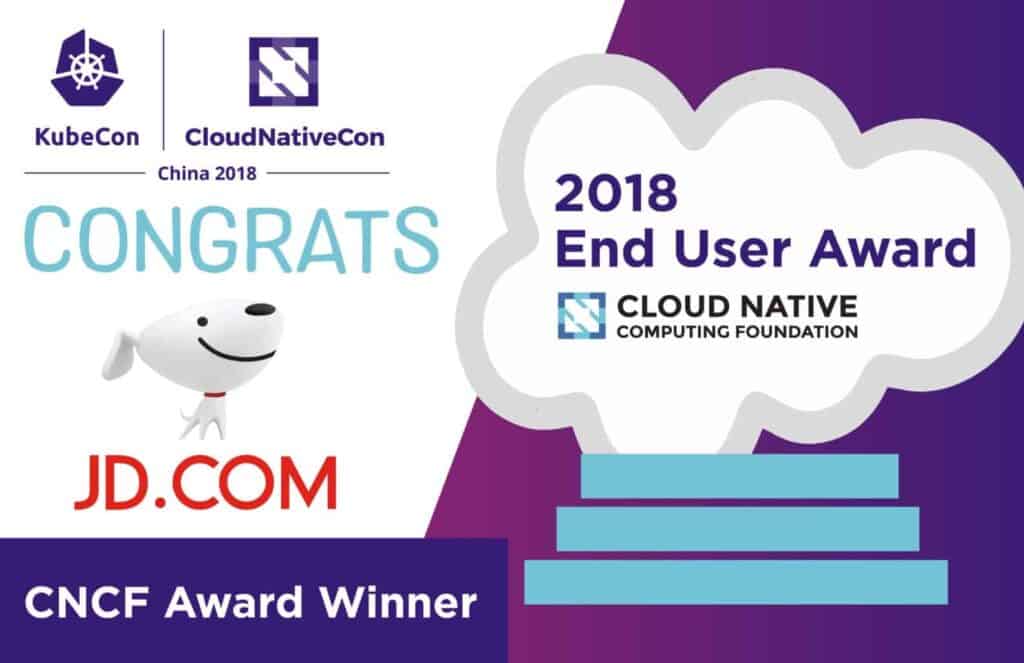
JD.com, China’s largest retailer, has been presented with the Top End User Award by the Cloud Native Computing Foundation (CNCF) for its unique usage of cloud native open source projects. The award was announced at China’s first KubeCon + CloudNativeCon conference hosted by CNCF, which gathered thousands of technologists and end users in Shanghai from November 13-15 to discuss the future of open source technology development.
Providing the ultimate e-commerce experience to customers requires JD to house and process enormous amount of information that must be accessible at incredibly fast speeds. To put it in perspective, five years ago there were only about two billion images in JD’s product databases for customers. Today, there are more than one trillion, and that figure increases by 100 million images each day. This is why JD turned to CNCF’s Kubernetes project in recent years to accommodate its clusters.
JD currently runs the world’s largest Kubernetes cluster in production. The company first rolled out its containerized infrastructure a few years ago and, as the clusters grew, JD was one of the early adopters to shift to Kubernetes. The move, known as JDOS 2.0, marked the beginning of JD’s partnership with CNCF to build stronger collaborative relationships with the industry’s top developers, end users, and vendors. Ultimately, CNCF provided a window for JD to both contribute to and benefit from open source development.
In April, JD became the CNCF’s first platinum end user member, and took a seat on the organization’s governance board in order to help shape the direction of future Foundation initiatives. JD’s overall commitment to open source is highly aligned with its broader Retail as a Service strategy in which the company is empowering other retailers, partners, and industries with a broad range of capabilities in order to increase efficiency, reduce costs, and provide a higher level of customer service.
JD’s Kubernetes clusters support a wide range of workloads and big data and AI-based applications. The platform has boosted collaboration and enhanced productivity by reducing silos between operations and DevOps teams. As a result, JD has contributed code to projects such as Vitess, Prometheus, Kubernetes, CNI (Container Networking Interface), and Helm as part of its collaboration with CNCF.
“One contribution that we are very proud of is Vitess, the CNCF project for scalable MySQL cluster management,” said Haifeng Liu, chief architect, JD.com. “We are not only the largest end user of Vitess, but also a very active and significant contributor. We’re looking forward to working together with CNCF and its members to pave the way for future development of open source technology.”
Vitess allows JD to manage resources much more flexibly and efficiently, reducing operational and maintenance costs, and JD has one of the world’s most complex Vitess deployments. The company is actively collaborating with the CNCF community to add new features such as subquery support and global transactions, setting industry benchmarks.
“JD spearheads the use of cloud native technologies at scale within the APAC market, and is responsible for one of the largest Kubernetes deployments in the world,” said Chris Aniszczyk, COO of Cloud Native Computing Foundation. “The company also makes significant contributions to CNCF projects and its involvement in the community made JD a natural fit for this award.”
JD will continue to work on contributions to cloud native technologies as well as release its own internal and homegrown open source projects to empower others in the community.
京东(JD.com)应用云原生开源技术荣获“云原生计算基金会 (CNCF) 最佳终端用户奖”
作者:京东(JD.com)

中国最大的零售商京东因其开创性地使用云原生开源项目荣获“云原生计算基金会最佳终端用户奖”。11 月 13 日至 15 日,几千名技术人员和终端用户齐聚上海,参加云原生计算基金会举办的中国首届 KubeCon + CloudNativeCon,探讨开源技术的未来发展,主办方也在会上隆重宣布了这一奖项。
为了向客户提供最佳的电子商务体验,京东必须储存和处理庞大的信息量,以确保人们可以用快到不可思议的速度访问该信息。相比五年之前,京东的客户产品数据库中仅有大约 20 亿张图片。如今,京东数据库已有超过 一万亿张图片,并正以每天 1 亿张图片的速度增长。正因为如此,近年来,京东将目光转向了云原生计算基金会的 Kubernetes 项目,以因应企业集群。
目前,京东在生产中运行着全世界最庞大的Kubernetes 集群。几年前,公司首次推广容器化基础架构,并且,随着集群规模的增加,京东成为 Kubernetes 集群的早期用户之一。此举便是众所周知的 JDOS 2.0,标志着京东与云原生计算基金会合作的开端,促使京东与业内顶级开发商、终端用户及供应商建立更强大的合作关系。最终,云原生计算基金会为京东提供了一个窗口,让京东既促进了开源技术的发展,又受益于它的发展。
今年 4 月,京东成为云原生计算基金会的首位白金级终端用户成员,并加入了该机构的管理委员会,帮助确定基金会未来的行动方向。京东对开源技术的总体承诺与该企业推行的“零售即服务”策略不谋而合,通过该策略,京东为其他零售商、合作伙伴和行业提供广泛支持,从而提高效率、降低成本、提供更高水平的客户服务。
京东的 Kubernetes 集群支持广泛的工作负载以及大数据和人工智能应用。该平台通过减少运营团队与 DevOps 之间的筒仓,促进了合作,提高了生产效率。所以,在与云原生计算基金会合作的过程中,京东为项目贡献了代码,比如 Vitess、Prometheus、Kubernetes、CNI(容器网路接口)以及 Helm。
京东首席架构师刘海锋表示“我们引以为傲的一个贡献是 Vitess,它是云原生计算基金会的一个可扩展性 MySQL 集群管理项目。我们不仅是最大的 Vitess 终端用户,还是非常活跃和重要的贡献者。我们期待与云原生计算基金会及其成员合作,为开源技术的未来发展开辟道路。”
Vitess 帮助京东更加灵活高效地管理资源,降低运营和维护成本,同时京东拥有世界上最复杂的 Vitess 部署之一。京东与云原生计算基金会社圈积极合作,增加新功能(比如子查询支持与全球交易),设定行业基准。
云原生计算基金会的首席运营官 Chris Aniszczyk 表示,“京东在亚太市场带头大规模使用云原生技术,并负责完成世界上最大的 Kubernetes 部署之一。该公司为云原生计算基金会的项目做出了巨大贡献,正是因为京东的参与,它获得这一奖项当之无愧。”
京东将继续努力为云原生技术做出贡献,同时发布自己的内部本土开源项目,为圈内的其他参与者提供支持。